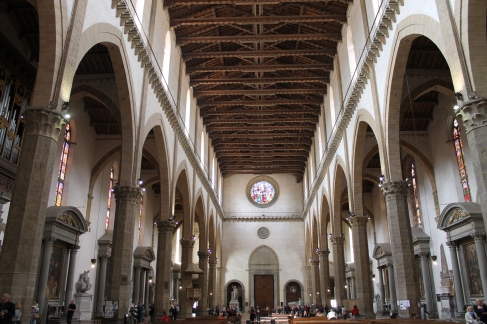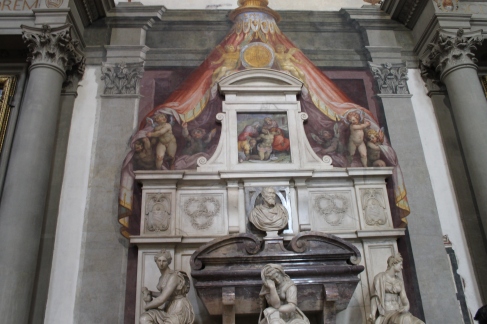On Wednesday of our first travel break, I visited the Basilica di Santa Croce, located in Florence, Italy. Santa Croce is a Roman Catholic Church, but is also a Franciscan Church. When it was first constructed, it was technically outside of the city walls, but now it is considered part of the city. Construction began in the late 13th century and the Basilica was consecrated in 1443 and serves as the main Franciscan church in Florence and as one of the minor basilicas of the Roman Catholic Church. The church still holds services, but it also serves as a major tourist destination because of the churches significance. Not only is it an important Catholic Basilica, it serves as a burial ground for some of the greatest minds in the western world; including Galileo, Machiavelli, Rossini, Michelangelo and Dante. Since so many famous people are entombed at Santa Croce, it is sometimes also called the “Temple of the Italian Glories.”
The Basilica has sixteen chapels within it, including one larger chapel to the right of the nave which has extremely detailed and ornate frescos covering the walls and the ceiling. The chairs that line the chapel were also hand carved by different artists. This larger chapel served as more of a museum with relics that were on display. One of these was the robe that St. Francis wore during his ministry and prior to his death.
Each person who is buried in the chapel has a different type of tomb. The decorations often had to do with their life’s work and included details of their personal lives and preferences. Michelangelo’s tomb, for example, was one of the only tombs that included a lot of color. The details on the sculptures of his tomb were exquisite and very reminiscent of artwork that he himself would have created. There were also explanations of why each tomb was decorated and dressed in a certain way. One of the most detailed descriptions was that of Galileo; a lot of symbolism went into the creation and installation of his tomb.
Although I was not expecting it at all, visiting Santa Croce was an extremely spiritual experience. One of the best parts of our visit was that I was able to light a candle and just use that as a time of spiritual renewal and meditation. It was 50 cents, but I figured that there was probably not ever going to be a chance for me to light a candle in Santa Croce, so I paid and lit a candle in memory of all of my grandparents. It was overwhelming to be in the church where so many amazing and talented thinkers and artists were laid to rest.
Visiting this church was a connecting moment for me because sometimes it’s hard for me to remember that Catholicism and Protestantism are both part of the same religion. This church was consecrated prior to the Protestant Reformation which was in the early 1500’s, so it was interesting to see this basilica knowing that at that point in time Protestantism did not even exist. I think all of us that are studying here have acted like Catholicism is extremely different from our religion, which in most cases, is something of the protestant sect. Other than sacramental values like transubstantiation and infant baptism, both arguably have some of the same fundamental beliefs. I think many of us here in Sansepolcro have assumed that their religion is really different from ours because they practice it so differently.
When we observed church in Sansepolcro, it was literally like social hour in the Catedrale. The fact that I was people watching while in the Catedrale kept me from observing the actual ritual of worship that was going on. Visiting Santa Croce and taking in all of the paintings, carvings and sculptures of Jesus and Mary made me realize that I had more in common with Catholicism than I’ve always thought. Since I’m an RES minor, I obviously knew that Catholic wasn’t extremely different from Protestantism. Something about being in an Italian basilica which was built during the 15th century really caused me to connect with Catholicism on an emotional level. Even though I had been to Catholic services before, something about this trip to Santa Croce was much more emotional than my usual strictly academic interpretations of the Catholic faith.


